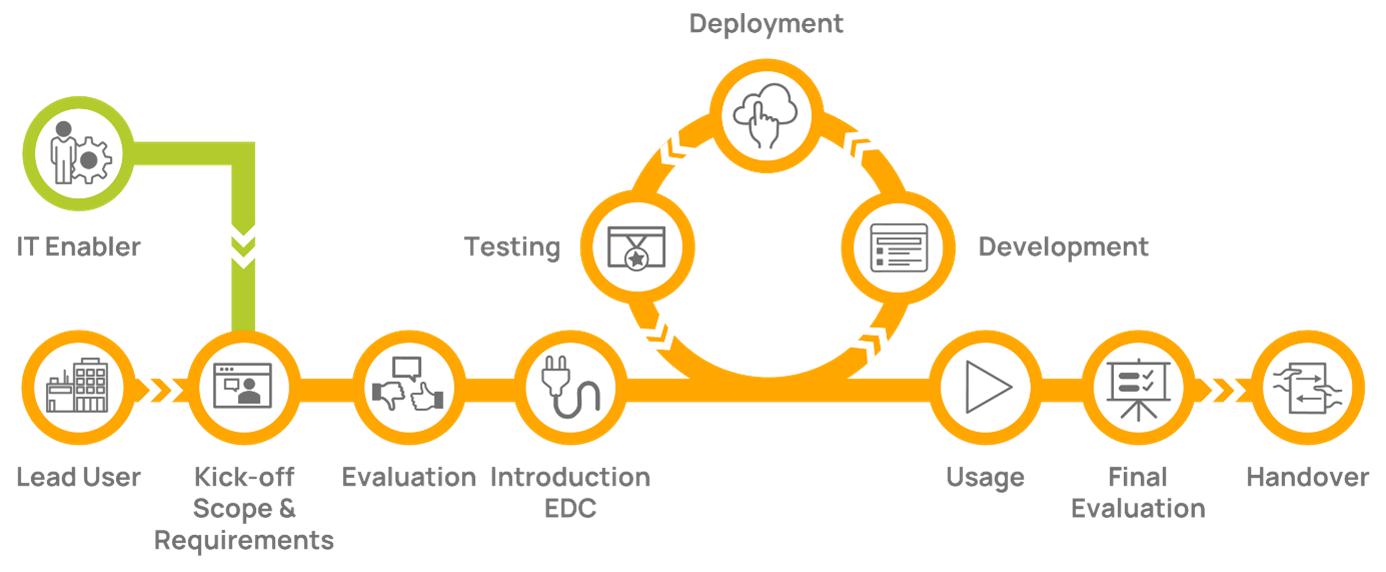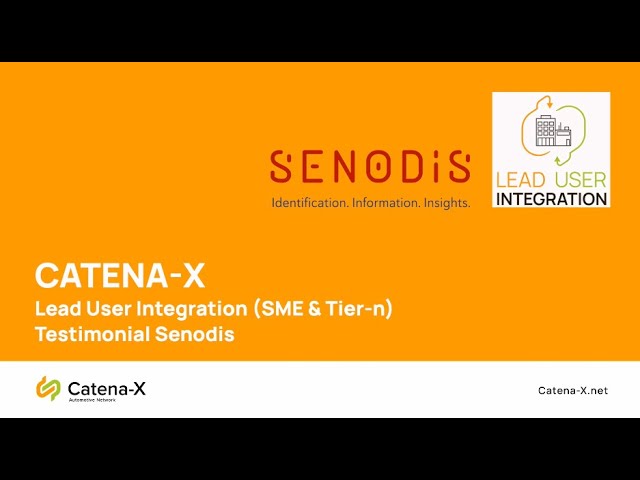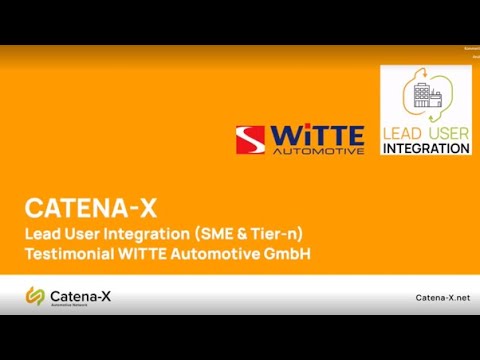Lead User Integration
Catena-X is a data ecosystem whose added value derives from providing end-to-end data chains along the automotive industry and from making the data exchange between market participants sovereign, secure and simple. The involvement of Lead Users is therefore a major step in demonstrating the practicability of the results developed in the Catena-X project.
Motivation
The current challenge is to ensure the creation of the prerequisites of the data ecosystem as well as the actual development/programming and operation of the ecosystem in a coordinated approach.
Necessary components for building the data ecosystem and data exchange are developed in the Catena-X Community. Adaptation in the value chain largely depends on whether the components and the connection process meet the needs of all partners. The task is to capture the requirements of all partners in the value chain and to design the solutions according to the situation.
Goal
Lead User integration focuses on hands-on testing of the Eclipse Data Space Connector (EDC) for end users. The EDC is the gateway component to Catena-X. The goal is to equip the Lead User with a running EDC and thereby identify challenges and needs in lessons learned, for example, to make routines such as the on-boarding process and other Catena-X activities as lean and efficient as possible.
For more information on EDC, please also read the Lead User Integration Scope & Requirements document.
Lead User Process
As part of the connection process, there is an intense dialog between Lead Users and the so-called IT Enabler. The infrastructures and interfaces of the Lead Users are identified and specified, requirements are documented, and the technology implementation is guided or carried out so that Lead Users can successfully exchange data based on the Catena-X technology. The IT Enabler supports the connection process on a technical level. In this context, support means that the IT Enabler provides the Lead User company with guidance, e. g. with an IT consultant who is remotely connected to an employee of the Lead User company. The IT Enabler helps with development, setup, operation, integration, and usage of the connector technology. This can include a step-by-step explanation how to set up the EDC or provision of running connectors.

The Lead User integration process consists of defined steps to meet the Lead User’s requirements:
- Acquisition of Lead Users through the Catena-X network.
- Kick-off Scope & Requirements: After the acquisition by the Catena-X team, the kick-off meeting with the IT Enabler takes place as well as first in-depth interviews on the IT infrastructure and the goals of the company with Catena-X. The aim is to understand the overall IT landscape of the company and the systems relevant for the connection, further narrowing down the scope of individual systems that are to be connected. At the end of the meeting, the potential Lead User should be able to decide if they want to participate in the Lead User integration and what resources/employees they need to do so.
- Evaluation aims to determine if the potential Lead User wants to perform the Lead User integration process and they should be able to define an implementation team that can perform the technical implementation together with the IT Enabler.
- Introduction EDC: The possible deployment scenarios for the EDC are evaluated, as well as a further assessment of the Lead User's systems and capacities, if required.
- Development: Together with the IT Enabler, the IT employee can perform the initial setup and preparation for the use of the connector.
- Deployment of the required components is set up in a cloud environment (e.g. Azure). IMPORTANT: Steps 5 and 6 can be taken over by IT Enabler in case of provision of connectors.
- Testing: In these steps, (test) systems of the Lead User are integrated and test data is sent between the EDC of the Lead User and the EDC of the IT Enabler to test the functionality of the EDC. At the end, the Lead User has access to a running connector. IMPORTANT: Synthetic data (single string, empty sample file) can be used as test data. It is not necessary to use "real" data!
- Usage: The Lead User is trained in usage of connector technology and can use the connector for data exchange in the test environment. This enables gathering experience, e. g. as preparation for use cases or for integration of various data sources and environments.
- Final Evaluation: A feedback questionnaire is used for the summary of all lessons learned and best practices. This serves as the basis for the concept of operations and the handbook.
- Hand Over (optional): According to preference and interest, the Lead User can, for example, be involved in the development of success stories, such as videos. Or participate in case studies and use cases (separate CX team), and much more.
Roles and Responsibilities
Lead User
A Lead User is a potential participant from the mid-market to join the Catena-X ecosystem in the future operating environment. In the Lead User integration process, the Lead User takes the role of a Catena-X participant and tests the EDC needed for later Catena-X applications.
Several parties are involved at the Lead User side:
- Management: Decision makers with authority to commit resources to the Lead User integration process.
- IT Implementation Team: Possesses skills and competencies to implement EDC as well as authorizations/access to cloud infrastructures of the Lead User (e.g. test environments) and capacities (time, resources) to perform EDC implementation.
- Business-Team (Optional): Assumes responsibility for Catena-X use cases.
Catena-X Team
The Catena-X team consists of the consortium partners. Their tasks are to achieve the goals, milestones, coordination, and communication with the Catena-X development consortium.
IT-Enabler
The IT Enabler is a subcontracted project partner who supports the Lead User integration with his know-how. His task is the testing of the EDC with Lead Users. He also takes on an advisory role and supports the Lead Users throughout the entire connection process.
For more information on the involved roles and further information on the Lead User intergration process, read the Lead User Integration Scope & Requirements document.
Benefits
As part of the Lead User integration, we are looking for small and medium-sized enterprises (SME) that we will support and guide during the practical connection to the Catena-X technology. Together with our IT Enabler, we design the technical implementation of the EDC in a secure test environment tailored to your company.
- Participate as one of the companies in Catena-X.
- Get first practical trials in the Catena-X network.
- Consider individual circumstances at SME, tier-n.
- Get a review of your IT environment for using the EDC.
- Get technical support for your IT staff (EDC vs. data, cloud services, etc.).
- After implementation, there is an opportunity to participate in Catena-X use cases.
- Implementation in 4-8 weeks, 1h/week workload for your staff (depending on your architecture and individual requirements).

This is a work result of the
Catena-X Automotive Network Consortium Project,
supported by the German Federal Ministry for Economic Affairs and Climate Action.
Funding code: 13IK004*

Carl Wedepohl
Find out more about the Lead User Integration process
Lead user integration - first-hand experience



